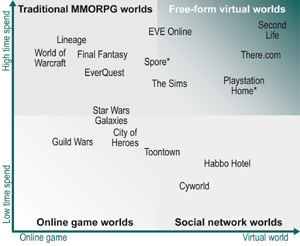A Paradoxical Proposition, Are People More Real Where They Live Their Dreams?—Zapped by Conventional Thinking
 Gaming and virtual worlds like Second Life have been a hot topic due to their novelty and, where gaming is concerned, their Gen X and Gen Y demographics. However, early adopter marketers who have flocked to virtual worlds to create presences there have often been disappointed. Forrester’s Paul Jackson is a long-time follower of gaming and virtual worlds, and he gave a fascinating and valuable session on the status and best practices for how marketers can approach this new medium. He also gave a rough ROI picture of investing. Just like anything, if you approach virtual worlds with appropriate goals, you can benefit significantly.
Gaming and virtual worlds like Second Life have been a hot topic due to their novelty and, where gaming is concerned, their Gen X and Gen Y demographics. However, early adopter marketers who have flocked to virtual worlds to create presences there have often been disappointed. Forrester’s Paul Jackson is a long-time follower of gaming and virtual worlds, and he gave a fascinating and valuable session on the status and best practices for how marketers can approach this new medium. He also gave a rough ROI picture of investing. Just like anything, if you approach virtual worlds with appropriate goals, you can benefit significantly.
An Overview of Games and Virtual Worlds
Jackson began with a history of virtual worlds and gaming, which are both inherently social (and usually sticky). Gaming began in the 1970s with multiuser Dungeons, and many early games were played on the VAX. The 1990s introduced 3-D graphics and VRML as well as massively multiuser games like Lineage, EverQuest and the World of Warcraft. Then Jackson presented a 2×2 to define games and worlds in terms of the average stickiness, which I’ve reproduced below right (click to view larger). For more on the games themselves, see Wikipedia’s History of MMORPGs and its List of MMORPGs.
Virtual worlds such as Second Life are not games, their inhabitants will insist. Most see themselves as serious world builders; they are not there to amuse themselves. Although not the first, Second Life opened the gates for marketers. There.com is another virtual world, and its parent has a division that consults to the military (simulations).
 Jackson addressed worlds and games that had a heavy social element. MMORPGs (massively multiplayer online role playing game) like World of Warcraft involve significant time investment like virtual worlds, but the emphasis is on overcoming the challenges of the game. (The two “low-spend” categories are less involved but still attract intense attention to their adherents who are overwhelmingly hard-to-reach Gen Xers and Gen Yers. Cyworld‘s penetration in South Korea is north of 90%, according to some estimates). Webkinz are borderline, since they are plushies (stuffed animals) that also include an online component.
Jackson addressed worlds and games that had a heavy social element. MMORPGs (massively multiplayer online role playing game) like World of Warcraft involve significant time investment like virtual worlds, but the emphasis is on overcoming the challenges of the game. (The two “low-spend” categories are less involved but still attract intense attention to their adherents who are overwhelmingly hard-to-reach Gen Xers and Gen Yers. Cyworld‘s penetration in South Korea is north of 90%, according to some estimates). Webkinz are borderline, since they are plushies (stuffed animals) that also include an online component.
The Potential for Marketers
For marketers, virtual worlds and games offer a new frontier to connect with customers. Jackson counseled marketers to approach with realistic goals, and he outlined a two-fold value proposition: these worlds have very passionate members, and if your company supports residents, they can form a relationship with the company and the product (that goes far beyond that of other media). Secondly, it is likely that the “virtual reality” element of games will increase its impact on all elements of digital communication over time, so your company would do well to understand the “in-world” environment. Elements of the virtual and gaming environment will become mainstream. Moreover, a presence in a virtual world can become a self-sustaining, virtuous circle. Jackson stipulated that, on average, when the world reaches 700,000 members, like Club Penguin, company presences can break even: their costs to participate are balanced by incremental revenue.
However, these worlds are far “nichier” than other venues to which marketers are accustomed, so realistic expectations and planning are key. Jackson pointed out that Second Life has only 89,000 “premium” residents. In addition, expect to go up the learning curve before you can navigate and interact with others in-world. (Companies that have held job fairs, for example, have encountered significant difficulties because interviewers and interviewees struggle significantly with basic navigation). Lastly, there is growing media backlash against the worlds, and participating might have unexpected consequences for your brand.
Several major brands have made significant Second Life investments: Toyota, Sun, Nokia, IBM, Disney, Nike, Sony, Viacom and Coca-Cola. They buy in-world billboards, posters and avatars, and all have in-world locations. They host events and gain live feedback from people. Customers help them design campaigns (remember, you are among builders here, and they will go the extra mile to help you if your mission is to improve their world). Residents are influential creators whose influence goes beyond the virtual worlds. For example, Starwood is enlisting members in Second Life to help it build a luxury hotel, and members are extremely passionate about it. Sun, Cisco, IBM and Microsoft are running events and media conferences. Several corporations run recruiting campaigns.
 Virtual worlds and games can be used effectively as distribution channels for existing content, and you can use content developed in-world outside (but be careful of the context; in-world is a context that few people understand). MySpace is quite tired now but can still make a good investment (Ernest and Young and Adidas are among many that have done great things there for recruiting and community building around their brands). Regarding commerce, Second Life residents are a very attractive demographic for many marketers, and Second Life can be an excellent venue for gadget shops and things high tech. Environmentalism is often of high interest to residents.
Virtual worlds and games can be used effectively as distribution channels for existing content, and you can use content developed in-world outside (but be careful of the context; in-world is a context that few people understand). MySpace is quite tired now but can still make a good investment (Ernest and Young and Adidas are among many that have done great things there for recruiting and community building around their brands). Regarding commerce, Second Life residents are a very attractive demographic for many marketers, and Second Life can be an excellent venue for gadget shops and things high tech. Environmentalism is often of high interest to residents.
Getting Involved: Costs and Benefits
Despite the risks, virtual worlds offer a unique opportunity for marketers to connect with customers and prospects, and Jackson laid out basic guidelines for what companies have been investing and what they have seen in terms of benefits. Benefits fall into two areas: B2B training and B2C marketing, public relations, social networks, community and C2C commerce. Investments fall into two main categories: 1) join and existing community or 2) build your own using toolkits such as MTV’s Virtual Laguna Beach. For the former, you can take out in-world advertising, run promotions, support in-world initiatives (sponsor buildings or associations), recruit, hold focus groups and build your own presence (a store, or location). Once you build a location, you have to staff it, pay rent, etc.
- A full presence typically costs $100,000-$200,000, which includes subscriptions, buying/renting land or space, a creative agency to build your space and staffing to man it. For many companies, this is a modest investment.
- A more aggressive approach is running full in-world campaigns and integrating them with online and offline activities. You can also build or buy a revenue-generating world. Coca-Cola has executed the most comprehensive Second Life campaign thus far; they have spent $1-2 million on the “Virtual Thirst.” Residents can design their own Coke machines, and there are myriad activities and promotions.
- Jackson closed with the “five steps to virtual happiness”:
- Find out what your company has done so far
- Develop the business case and measurements for success
- Based on this, decide whether to build, buy or partner
- Create and maintain your presence (the marketing golden rule certain applies here: you need a sustainable program to achieve results)
- Create a continuous feedback loop involving consumers, partners and staff
Analysis and Conclusions
 Gaming and virtual worlds are unique venues for marketers, so be prepared to think differently about the entire marketing value proposition. While traditional marketers might dismiss their paltry numbers, these worlds represent the crème de la crème of online collaboration, which offers the opportunity to understand online collaboration itself.
Gaming and virtual worlds are unique venues for marketers, so be prepared to think differently about the entire marketing value proposition. While traditional marketers might dismiss their paltry numbers, these worlds represent the crème de la crème of online collaboration, which offers the opportunity to understand online collaboration itself.- Most people in these worlds are creators and builders, and they are very excited about what they are creating. If your offering is introduced appropriately and respects what they are trying to accomplish, you can gain strong supporters, both “in world” and out.
- Product placement and advertising opportunities exist “in world” and “in game,” which can enable you to engage hard-to-reach demographics in a context in which they are less cynical. Many Gen X/Y are extremely jaded and cynical about mass media and advertising.
- Think about the concept of creating or participating in a virtual world or game. For many people, it represents a highly personal opportunity to “create a better place” and thus means idealism and aspiration on a large scale. To tap into the potential, think about what people are trying to accomplish and how you can help them. This is an opportunity to form a completely different kind of customer relationship.
- If you approach virtual worlds with conventional marketing thinking, you’ll be zapped and written off. Conventional markets and crass numbers-driven messages are precisely one thing people are trying to avoid by going to these worlds. There are different rules of engagement. Throw the standard metrics out the window because you’re on a different scale of risk and reward.
- Virtual worlds and gaming represent the quintessential Web 2.0 opportunity. See Web 2.0 Means Marketing 2.0.

Leave a Reply
You must be logged in to post a comment.